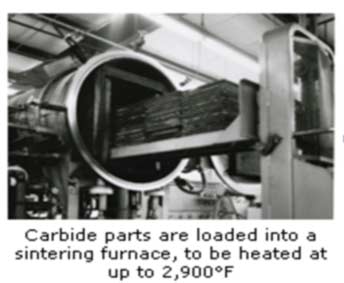The materials from which cutting tools are made are all characteristically hard and strong. There is a wide range of tool materials available for machining operations, and the general classification and use of these materials are of interest here.

Tool Steels and Cast Alloys
Plain carbon tool steel is the oldest of the tool materials dating back hundreds of years. In simple terms, it is a high-carbon steel, which contains about 1.05% carbon. This high carbon content allows the steel to be hardened, offering greater resistance to abrasive wear. Plain high carbon steel served its purpose well for many years. However, because it is quickly over tempered (softened) at relatively low cutting temperatures (300 to 500°F), it is now rarely used as cutting tool material except in files, saw blades, chisels, etc. The use of plain high carbon steel is limited to low heat applications.
High Speed Tool Steel: The need for tool materials that could withstand increased cutting speeds and temperatures led to the development of high-speed tool steels (HSS). The major difference between HSS and plain high carbon steel is the addition of alloying elements to harden and strengthen the steel and make it more resistant to heat (hot hardness).
Some of the most commonly used alloying elements are manganese, chromium, tungsten, vanadium, molybdenum, cobalt, and niobium. While each of these elements will add certain specific desirable characteristics, it can be generally state that they add deep hardening capability, high hot hardness, resistance to abrasive wear, and strength, to HSS. These characteristics allow relatively higher machining speeds and improved performance over plain high carbon steel.
The most common HSS used primarily as cutting tools are divided into the M and T series. The M series represents tool steels of molybdenum type and the T series represents Tungsten. Although there seems to be a great deal of similarly among these HSS, each one serves a specific purpose and offers significant benefits in its special application.
An important point to remember is that none of the alloying elements for either series of HSS is in abundant supply and the cost of these elements is skyrocketing. In addition, U.S. manufacturers must rely on foreign countries for supply of these very important elements.
Some of the HSS are now available in powdered metal (PM) form. The difference between powdered and conventional metals is in the method by which they are made. The majority of conventional HSS is poured into an ingot, and then, either hot or cold, worked to the desired shape. Powdered metal is exactly as its name indicates. Basically the same elements that are used in conventional high-speed steel are prepared in a very fine powdered form. These powdered elements are carefully blended together, pressed into a die under extremely high pressure, and then sintered in an atmospherically controlled furnace.
HSS Surface Treatment: Many surface treatments have been developed in an attempt to extend tool life, reduce power consumption, and to control other factors that affect operating conditions and costs. Some of these treatments have been used for many years and have proven to have some value. For example, the black oxide coatings that commonly appear on drills and taps are of value as a deterrent to build-up on the tool. The black oxide is basically ‘dirty’ surface that discourages the build-up of work material.
One of the more recent developments in coatings for HHS is titanium nitride by the physical vapor deposition (PVD) method. Titanium nitride is deposited on the tool surface in one of several different types of furnace at relatively low temperature, which does not significantly affect the heat treatment (hardness) of the tool being coated. This coating is known to extend the life of a cutting tool significantly or to allow the tool to be used at higher operating speeds. Tool life can be extended by as much as three times, or operating speeds can be increased up to 50%.